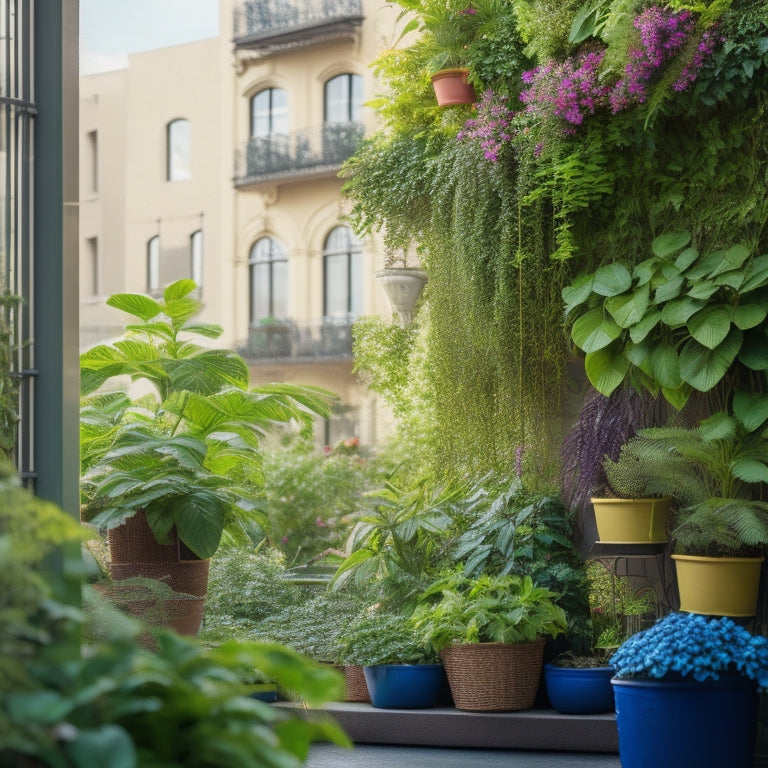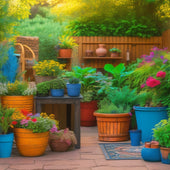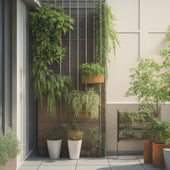
Why Vertical Gardening Beats Urban Space Constraints
Share
As you navigate urban space constraints, vertical gardening offers a clever solution to transform walls, rooftops, and small yards into productive gardens. By maximizing upward growth, you'll increase yields while minimizing space and water usage. Strategies like container gardening, tiered plantings, and wall-mounted planters enhance visual interest and optimize small yard potential. By cultivating vertically, you'll not only beat the small yard blues but also create a sustainable and eco-friendly environment. From overcoming shade challenges to incorporating innovative solutions, you'll reveal the full potential of your urban space - and that's just the beginning of your vertical gardening journey.
Key Takeaways
• Vertical gardening transforms urban spaces into productive gardens, increasing yield while minimizing space and water usage.
• It utilizes walls, rooftops, and balconies, maximizing vertical space and overcoming urban space constraints.
• Container gardening, tiered plantings, and wall-mounted planters optimize small yard potential and enhance visual interest.
• Vertical gardening reduces urban heat island effects, provides insulation, and contributes to a sustainable and eco-friendly environment.
• Innovative solutions like hydroponics, repurposed materials, and LED grow lights address specific challenges, making vertical gardening a viable urban solution.
Maximizing Urban Space Potential
By adopting vertical gardening, urban dwellers can access the hidden potential of their cramped city spaces, transforming once-barren walls and rooftops into lush, productive gardens.
You'll be surprised at how much you can grow in a small area, making the most of every available inch. Vertical farming allows you to cultivate a wide range of crops, from leafy greens to vining vegetables, on walls, trellises, or even windowsills.
Rooftop gardens, in particular, offer a unique opportunity to create a thriving ecosystem, providing insulation and reducing urban heat island effects.
With vertical gardening, you can increase your yield while minimizing space and water usage. By utilizing hydroponics, aeroponics, or other soilless methods, you can optimize your harvest and reduce maintenance.
By integrating vertical farming into your urban space, you'll not only enjoy a bountiful harvest but also contribute to a more sustainable, eco-friendly environment.
Beating the Small Yard Blues
Your small yard's limitations don't have to dictate your gardening aspirations, as clever design and strategic plant choices can transform even the most compact outdoor spaces into thriving vertical gardens. By adopting a vertical approach, you can optimize your yard's potential and enjoy a lush oasis despite its small size.
Here are three key strategies to help you beat the small yard blues:
-
Container gardening: Use space-saving containers that can be placed on walls, fences, or even the ground to add depth and visual interest to your garden. Choose containers with good drainage and a built-in water reservoir to minimize maintenance.
-
Vertical planters: Select planters that can be mounted on walls or trellises, allowing you to grow vining plants like ivy, clematis, or flowering vines. This won't only save space but also create a stunning display.
-
Tiered plantings: Create a multi-level garden by using raised beds, planters, or shelves to create a layered effect. This will add texture, depth, and visual interest to your small yard.
Growing Upwards Not Outwards
To maximize space in your small yard, focus on growing upwards with trellises, arbors, and wall-mounted planters that support vining plants, flowering climbers, or cascading greenery. This approach allows you to make the most of your vertical space, increasing your garden's productivity without sacrificing style.
Growing upwards offers several benefits, including:
| Vertical Plant Benefits | Space Saving Techniques | Visual Impact |
|---|---|---|
| Increased yields | Wall-mounted planters | Cascading flowers |
| Improved air circulation | Trellises for climbing plants | Vibrant foliage |
| Reduced soil erosion | Arbors for shade | Whimsical, layered look |
| Enhanced aesthetics | Vertical gardens for small spaces | Dramatic, lush displays |
Overcoming Density and Shade
In densely planted areas, clever use of vertical gardening strategies can help you outsmart shade and density constraints, creating an oasis of productivity in even the most challenging environments.
To overcome density and shade, consider the following strategies:
-
Select shade-tolerant plants: Choose plants that thrive in low-light conditions, such as leafy greens, herbs, and ferns. This will guarantee your vertical garden remains productive even in shaded areas.
-
Optimize vertical structures: Design your vertical structures to maximize sunlight exposure. Use trellises, arbors, or wall-mounted planters to train vining plants upwards, making the most of available light.
-
Utilize reflective surfaces: Incorporate reflective surfaces, such as mirrors or aluminum foil, to bounce sunlight onto shaded areas. This technique can increase light exposure by up to 20%.
Unconventional Gardening Solutions
Beyond traditional gardening methods, you'll find innovative solutions that repurpose unexpected materials, breathing new life into small or irregularly shaped spaces.
Container gardening, for instance, allows you to utilize vertical walls, balconies, or rooftops, making the most of available space. You can use recycled pallets, old boots, or even hanging baskets to create a thriving garden.
Hydroponic systems are another unconventional solution, providing a soilless cultivation method that maximizes yields while minimizing water consumption. These systems can be integrated into small spaces, such as indoor rooms or balconies, offering a high-tech approach to urban gardening.
When exploring unconventional gardening solutions, consider the specific challenges of your space. Do you have limited sunlight? Look into hydroponic systems or LED grow lights. Is your soil poor quality? Container gardening might be the answer.
Frequently Asked Questions
Can I Use Vertical Gardening for Root Vegetables Like Carrots and Potatoes?
You can grow certain root vegetable varieties, like radishes and beets, using vertical planting techniques, but carrots and potatoes require deeper soil, making them less suitable for vertical gardening, so consider alternative methods.
How Do I Protect My Vertical Garden From Strong Winds and Harsh Weather?
You'll be surprised to know that 80% of urban gardens are damaged by strong winds! To protect your vertical garden, install wind barriers, use weather-resistant materials, and anchor your system securely to guarantee stability and minimize damage.
Are Vertical Gardens More Prone to Pests and Diseases Than Traditional Gardens?
You'll face similar pest and disease risks in vertical gardens as traditional ones, but with proper pest management and disease prevention strategies, like pruning, sanitation, and biological controls, you can minimize these threats and maintain a healthy harvest.
Can I Use Vertical Gardening Methods for Indoor Spaces With Limited Natural Light?
You can successfully implement vertical gardening methods in indoor spaces with limited natural light by selecting low-light plants and optimizing indoor gardening conditions, such as using grow lights and precise temperature control.
Do Vertical Gardens Require More Maintenance Than Traditional Gardening Methods?
You might think vertical gardens are high-maintenance, but they're not! You'll actually spend less time on maintenance by using efficient techniques like drip irrigation and pruning, plus choosing low-maintenance plants to thrive in your indoor space.
Related Posts
-

3 Best DIY Planter Ideas for Backyard Decor
You can elevate your backyard's style and functionality by choosing the right DIY planter ideas. Start with a mix of ...
-

3 Best DIY Planter Ideas for Backyard Decor
You can elevate your backyard's style and functionality by choosing the right DIY planter ideas. Start with a mix of ...
-

3 Best DIY Planter Ideas for Backyard Decor
You can elevate your backyard's style and functionality by choosing the right DIY planter ideas. Start with a mix of ...
-

3 Best DIY Planter Ideas for Backyard Decor
You can elevate your backyard's style and functionality by choosing the right DIY planter ideas. Start with a mix of ...
-

3 Best DIY Planter Ideas for Backyard Decor
You can elevate your backyard's style and functionality by choosing the right DIY planter ideas. Start with a mix of ...
-

3 Best DIY Planter Ideas for Backyard Decor
You can elevate your backyard's style and functionality by choosing the right DIY planter ideas. Start with a mix of ...
-

3 Best DIY Planter Ideas for Backyard Decor
You can elevate your backyard's style and functionality by choosing the right DIY planter ideas. Start with a mix of ...
-

3 Best DIY Planter Ideas for Backyard Decor
You can elevate your backyard's style and functionality by choosing the right DIY planter ideas. Start with a mix of ...
-

3 Best DIY Planter Ideas for Backyard Decor
You can elevate your backyard's style and functionality by choosing the right DIY planter ideas. Start with a mix of ...
-

3 Best DIY Planter Ideas for Backyard Decor
You can elevate your backyard's style and functionality by choosing the right DIY planter ideas. Start with a mix of ...
-

3 Best DIY Planter Ideas for Backyard Decor
You can elevate your backyard's style and functionality by choosing the right DIY planter ideas. Start with a mix of ...
-

3 Best DIY Planter Ideas for Backyard Decor
You can elevate your backyard's style and functionality by choosing the right DIY planter ideas. Start with a mix of ...
-

3 Best DIY Planter Ideas for Backyard Decor
You can elevate your backyard's style and functionality by choosing the right DIY planter ideas. Start with a mix of ...
-

3 Best DIY Planter Ideas for Backyard Decor
You can elevate your backyard's style and functionality by choosing the right DIY planter ideas. Start with a mix of ...
-

3 Best Space-Saving Gardening Ideas for Urban Renters
You can turn even the smallest urban space into a lush oasis by utilizing clever space-saving gardening ideas. Maximi...
-

3 Best Space-Saving Gardening Ideas for Urban Renters
You can turn even the smallest urban space into a lush oasis by utilizing clever space-saving gardening ideas. Maximi...
-

3 Best Space-Saving Gardening Ideas for Urban Renters
You can turn even the smallest urban space into a lush oasis by utilizing clever space-saving gardening ideas. Maximi...
-

3 Best Space-Saving Gardening Ideas for Urban Renters
You can turn even the smallest urban space into a lush oasis by utilizing clever space-saving gardening ideas. Maximi...
-

3 Best Space-Saving Gardening Ideas for Urban Renters
You can turn even the smallest urban space into a lush oasis by utilizing clever space-saving gardening ideas. Maximi...
-

3 Best Space-Saving Gardening Ideas for Urban Renters
You can turn even the smallest urban space into a lush oasis by utilizing clever space-saving gardening ideas. Maximi...
-

3 Best Space-Saving Gardening Ideas for Urban Renters
You can turn even the smallest urban space into a lush oasis by utilizing clever space-saving gardening ideas. Maximi...
-

3 Best Space-Saving Gardening Ideas for Urban Renters
You can turn even the smallest urban space into a lush oasis by utilizing clever space-saving gardening ideas. Maximi...
-

3 Best Space-Saving Gardening Ideas for Urban Renters
You can turn even the smallest urban space into a lush oasis by utilizing clever space-saving gardening ideas. Maximi...
-

3 Best Space-Saving Gardening Ideas for Urban Renters
You can turn even the smallest urban space into a lush oasis by utilizing clever space-saving gardening ideas. Maximi...
-

3 Best Space-Saving Gardening Ideas for Urban Renters
You can turn even the smallest urban space into a lush oasis by utilizing clever space-saving gardening ideas. Maximi...
-

3 Best Space-Saving Gardening Ideas for Urban Renters
You can turn even the smallest urban space into a lush oasis by utilizing clever space-saving gardening ideas. Maximi...
-

3 Best Space-Saving Gardening Ideas for Urban Renters
You can turn even the smallest urban space into a lush oasis by utilizing clever space-saving gardening ideas. Maximi...
-

3 Best Space-Saving Gardening Ideas for Urban Renters
You can turn even the smallest urban space into a lush oasis by utilizing clever space-saving gardening ideas. Maximi...
-

What to Know Before Upcycling Concrete Planters
When upcycling concrete planters, you'll want to start by evaluating the planter's size, shape, and condition to guar...
-

What to Know Before Upcycling Concrete Planters
When upcycling concrete planters, you'll want to start by evaluating the planter's size, shape, and condition to guar...
-

What to Know Before Upcycling Concrete Planters
When upcycling concrete planters, you'll want to start by evaluating the planter's size, shape, and condition to guar...
-

What to Know Before Upcycling Concrete Planters
When upcycling concrete planters, you'll want to start by evaluating the planter's size, shape, and condition to guar...
-

What to Know Before Upcycling Concrete Planters
When upcycling concrete planters, you'll want to start by evaluating the planter's size, shape, and condition to guar...
-

What to Know Before Upcycling Concrete Planters
When upcycling concrete planters, you'll want to start by evaluating the planter's size, shape, and condition to guar...
-

What to Know Before Upcycling Concrete Planters
When upcycling concrete planters, you'll want to start by evaluating the planter's size, shape, and condition to guar...
-

What to Know Before Upcycling Concrete Planters
When upcycling concrete planters, you'll want to start by evaluating the planter's size, shape, and condition to guar...
-

What to Know Before Upcycling Concrete Planters
When upcycling concrete planters, you'll want to start by evaluating the planter's size, shape, and condition to guar...
-

What to Know Before Upcycling Concrete Planters
When upcycling concrete planters, you'll want to start by evaluating the planter's size, shape, and condition to guar...
-

What to Know Before Upcycling Concrete Planters
When upcycling concrete planters, you'll want to start by evaluating the planter's size, shape, and condition to guar...
-

What to Know Before Upcycling Concrete Planters
When upcycling concrete planters, you'll want to start by evaluating the planter's size, shape, and condition to guar...
-

What to Know Before Upcycling Concrete Planters
When upcycling concrete planters, you'll want to start by evaluating the planter's size, shape, and condition to guar...
-

What to Know Before Upcycling Concrete Planters
When upcycling concrete planters, you'll want to start by evaluating the planter's size, shape, and condition to guar...
-

What to Know Before Upcycling Concrete Planters
When upcycling concrete planters, you'll want to start by evaluating the planter's size, shape, and condition to guar...
-

What to Know Before Upcycling Concrete Planters
When upcycling concrete planters, you'll want to start by evaluating the planter's size, shape, and condition to guar...
-

What to Know Before Upcycling Concrete Planters
When upcycling concrete planters, you'll want to start by evaluating the planter's size, shape, and condition to guar...
-

What to Know Before Upcycling Concrete Planters
When upcycling concrete planters, you'll want to start by evaluating the planter's size, shape, and condition to guar...
-

What to Know Before Upcycling Concrete Planters
When upcycling concrete planters, you'll want to start by evaluating the planter's size, shape, and condition to guar...
-

What to Know Before Upcycling Concrete Planters
When upcycling concrete planters, you'll want to start by evaluating the planter's size, shape, and condition to guar...
-

What to Know Before Upcycling Concrete Planters
When upcycling concrete planters, you'll want to start by evaluating the planter's size, shape, and condition to guar...
-

What to Know Before Upcycling Concrete Planters
When upcycling concrete planters, you'll want to start by evaluating the planter's size, shape, and condition to guar...
-

What to Know Before Upcycling Concrete Planters
When upcycling concrete planters, you'll want to start by evaluating the planter's size, shape, and condition to guar...


